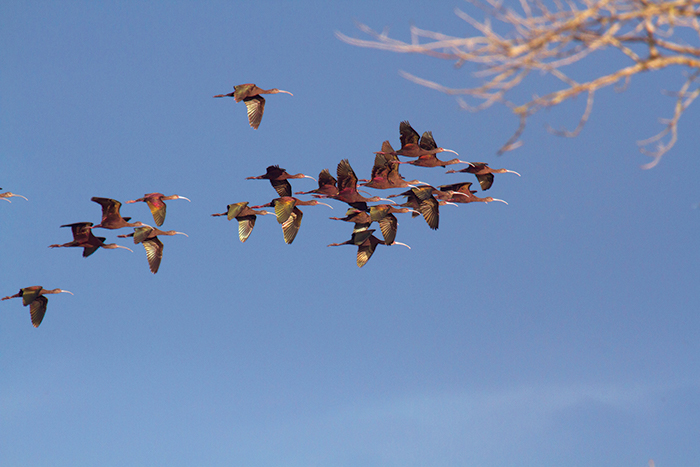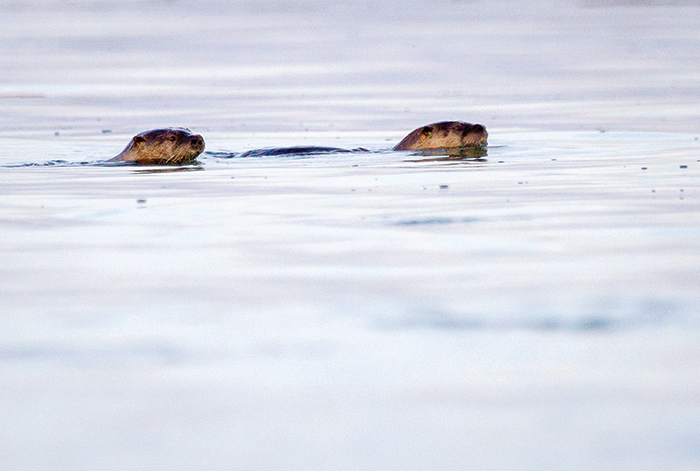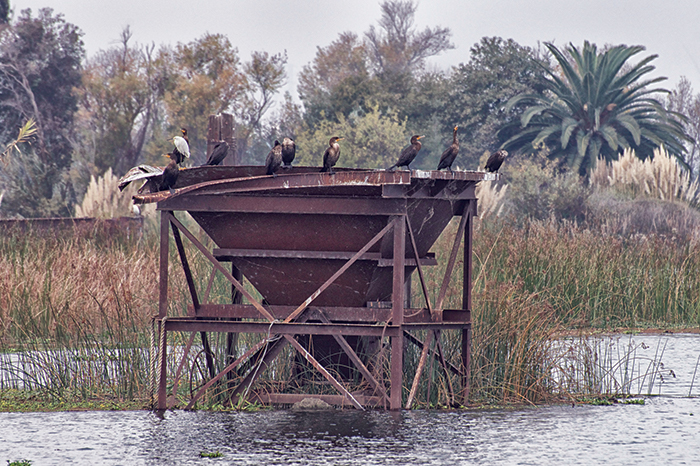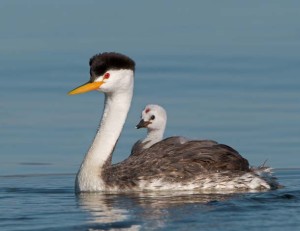Strings of birds have been passing overhead for the past 40 minutes. There are wobbly lines of starlings, Brewer’s and tricolored blackbirds, all of them flying east toward the sliver of sun that’s pushing above the horizon. They’re commuting to the farmland in the Central Valley where they’ll feed for the day, and tonight they’ll come back here to the Delta to overnight in the tule marshes. The sky is still a diluted blue, and as the flocks fly they call to one another, a cacophony known as the “dawn chorus.”
Mike Moran is pointing out and naming the birds as we stroll toward the water’s edge. We’re getting ready for an early morning kayak trip to seek out some of the birds that live around Big Break Regional Shoreline, which sits at the edge of Oakley, a small bedroom city on the San Joaquin River. The park and region is a hot spot for birding, and I’ve been curious about watching birds from the water, from a different perspective. “You can see the Delta from the Delta’s point of view,” Moran says.
And then right over our heads sails a clump of dark-colored bodies with long curved bills.
“Those are ibis!” Moran whoops. “That’s crazy. White-faced ibis you see as you drive up Highway 99 north of Sacramento in all the rice fields. They’re lousy up there. But I’ve never seen a flock of them here.”
In fact, he says, this is the farthest west he’s ever sighted ibis. Moran’s been a naturalist with the East Bay Regional Park District for nearly 25 years and became supervising naturalist at the Big Break Visitor Center when it opened in 2012, so I make a note to look up where else white-faced ibis have been seen in the area. (That night I check eBird, a website where birders can record their sightings, and the last sizable flock of ibis noted at Big Break was in 2000.)
“Well, that’s the sighting of the day,” he says.

Remember, they are an exotic species in the Western United States, and are rapidly increasing their geographic range and range of habitats. Are they outcompeting or excluding native species in the process? How would we know? We have done almost nothing to monitor changes in the assemblage of mushroom species in areas before and and after the incursion of death caps.
Further Reading
Pringle et al, “The ectomycorrhizal fungus Amanita phalloides was introduced and is expanding its range on the west coast of North America,” Molecular Biology 2009
Lockhart et al, “Simultaneous emergence of multidrug-resistant Candida auris on 3 continents confirmed by whole-genome sequencing and epidemiological analyses,” Clinical Infectious Diseases 2017
Battalani et al, “Aflatoxin B1 contamination in maize in Europe increases due to climate change,” Scientific Reports 2016
HOW TO KAYAK AT BIG BREAK
At Big Break you can bring your own kayak, join EBRPD’s regularly scheduled trips, or work with a nearby private outfitter. The boat launch is a small clearing at the muddy edge of the water adjacent to a viewing and fishing pier that juts 100 feet into the quiet inlet.
• If you bring your own kayak, you’ll be happy to hear there’s plenty of parking in the Big Break lot, and the park makes carts available to help you move your gear the quarter mile from the lot to the launch.
• The EBRPD schedules kayak trips about once a month that include an introduction to kayaking on land, followed by a 1.5- to 2.5-hour paddle with a park district guide. The “stable touring” kayaks hold one or two people, and you must be at least 8 years of age (11 for birding) and accompanied by an adult to participate. All trips are $30 plus fees. Sign up for a trip through the district’s Regional Activities guides or by contacting the reservations department at 1-888-EBPARKS.
• Based in Antioch, Delta Kayak Adventures rents equipment and leads trips exploring Big Break and elsewhere.
Tides
Big Break is subject to daily tides that can rise or fall as much as four feet every 6.25 hours. Tidal stations in Antioch and Three Mile Slough take readings, and Big Break is located roughly halfway between the two stations. A recommended app for keeping track of tides while boating is TideGraph.com.
Birding
For an update on the avian life birders are spotting at Big Break, check eBird.org (Big Break is listed as a birding hot spot on eBird).
San Francisco Bay Water Trail
In the S.F. Bay Water Trail’s growing network of boat launches, Big Break is its most eastern “trailhead.” The trail website profiles each trailhead and offers resources and maps for planning longer paddles between them.
We slide our two-person kayak from the muddy alcove near Big Break’s viewing and fishing pier into the still water. We’re in a shallow inlet off the San Joaquin River where the current is calm, perfect for watching birds from the water. It’s among the handful of areas in the Delta that hints at the region’s past richness in wildlife. About nine miles downstream from here the San Joaquin and Sacramento rivers converge, funneling 40 percent of California’s freshwater toward the San Francisco Bay and beyond. The tides from the Pacific reach 60 miles inland to raise and lower the water twice a day at Big Break. That mingling of salt water and freshwater, the swell and sink of tides, and all that dynamism are the ingredients for good bird and wildlife habitat. Emergent freshwater wetlands like those found at Big Break, that support tule and willow, grew across 746 square miles of the Sacramento–San Joaquin Delta before the Gold Rush. Today about 16 square miles of freshwater marsh remain. Big Break protects roughly a half square mile of that.
Hardly 50 feet from the shore, a giant, stilt-legged contraption, sagging at the shoreline, comes into full view. Perched on an arm of it a snowy egret eyes us carefully. Moran tells me that resting in front of us is a piece of San Francisco and Delta history. In 1878 State Dredge #2 became the second dredge ever commissioned by the state of California to scoop silt from the bottom of the Bay. It was deployed to deepen the approaches and berthing areas near the San Francisco wharves. Scuttled back here in 1932, the dredge is now part monument to another era and part living sculpture.
“This did the most of any bit of technology to change the Delta,” says Moran, “and now it’s out here getting reclaimed by the Delta.” Alders grow up and around the barge; a tangle of Himalayan blackberries consumes much of it. “You can see there’s stuff all over the place—a barge over there, a hopper over here. A lot of these islands have square corners because they’re old barges.”
The wildlife seems to be making do with what’s here. We stop paddling by a rusting hopper that once funneled things like grain or gravel onto a barge and now protrudes from the water like a giant tulip. Stuck to one side is a honeycomb-like collection of earthen nests built by cliff swallows, one little mud ball at a time. Moran tells me that when the tide goes out, the cliff swallows head for the soggy shoreline to collect beakfuls of mud. They fly back to the nest, deposit their scoop of mud on the wall, and slowly stack them row upon row like bricklayers. Nine hundred to twelve hundred mud balls later a cylindrical nest is stuck to the wall—of a cliff, a building, or a piece of the past—and next to it are more and more of the colony’s nests. A different kind of monument to industry.
Like much of the Delta, the area around Big Break was once cordoned off by levees that held back the marsh, the seasonal floods, and river to make way for farming on its rich soils. In 1927, a levee that kept out Dutch Slough and the river crumbled, causing 2.5 square miles of asparagus farm to flood — hence the name Big Break and the noticeably bulbous shape of the inlet. The levee was never repaired, the tule marsh returned, and to this day stray stalks of asparagus grow up amid the grasses surrounding Big Break.
We have barely left the cliff swallow nests when a black-crowned night-heron sails overhead, settling into the branches of a willow tree on the shore ahead of us. Before I can ask about the heron, Moran breaks in: “Oh! There’s an otter, off to your left, off to your left!” We watch the brown head of the river otter bob up and down right to the edge of a disintegrating platform—another abandoned barge—and hoist itself from the water. And then “Ah! There goes a Cooper’s hawk,” Moran calls in a loud whisper. I catch sight of the svelte hawk swooping in toward the tree housing the night-heron. With a disgruntled squawk, two herons lift from the branches and then resettle.
“It’s a juvenile and an adult,” Moran explains, pointing to the brown-and-white-speckled younger bird and the black-gray-and-white adult. Statue-still in the same tree hunches a great blue heron. A black phoebe hops along the otter barge (where a second otter has appeared), and a marsh wren chatters in the tules. A green heron takes flight.


The wildlife is a glimpse of the Delta prior to the Gold Rush when fresh and salt water wound through dendritic channels and spanned the 1,200 square miles of the Delta. Today almost 1,100 miles of levees slice up, divert, and redirect water into deep waterways. Newer technologies dredge silt from the channels, allowing ships from all over to head upriver to the port of Stockton, bringing with them a world of invasive species. But Big Break’s mix of plant life still includes native species, like the tall and slender tule, cattails, and bulrushes growing at the edge of the shore. This type of marsh likely once supported the most diverse population of birds in the Delta. Today the tule marsh at Big Break still shelters California black rails (listed as threatened by the state) and the elusive American bittern, and it’s the hunting grounds of herons and egrets.
The black-crowned night-heron and great blue heron we’ve caught sight of are fishing birds, and smart ones. Both species have been noted trying all sorts of tricks to catch fish. The night-heron vibrates its beak in the water to lure prey. It has also waited by a bit of bait, or even placed bait in the water, before picking off curious fish as they swim to the surface to investigate. Blue herons have been seen using the same strategy. The downside to being clever and successfully catching fish in the Delta, though, is the accumulation of mercury in smaller species. The Gold Rush’s legacy of mercury contamination in the Delta travels from little fish to birds to their avian embryos and causes myriad problems that can reduce nesting success. Moran says area naturalists know of one great blue heron nesting colony in Big Break, and though they’ve never found a night-heron nesting colony, “we’re pretty sure there’s one around here. We see so many juveniles.”
Almost on cue, seven, eight, and then a ninth night-heron emerge from the tangle of vegetation en masse, taking off across the water. Maybe they’d had enough of the Cooper’s hawk.

We’ve followed the shoreline for roughly a third of a mile since climbing in the boat, and glancing toward the open water I see another brown head pop to the surface, but it’s much bigger. “Is that a seal?” I ask. “Oh, no! It’s a sea lion!” Moran says; “Salmon are running now. It’s an adult male. See that big forehead?” We head into the open water, but the California sea lion catches sight of us and dives just beneath the surface, creating a thick, single wave that travels fast across the smooth water. And then suddenly he bursts through the surface, his full 500-pound body suspended above of the water. Then he crashes back under, only to burst through and dive down over and over again. Moran and I laugh out loud. I’ve never seen such a display! “That’s called porpoising,” Moran says and then explains that sea lions (usually lone males) do swim into the Delta to hunt. I’m surprised and cautiously happy that for all the Delta’s ailments, it’s possible to see so much life in less than an hour on the water. We’ve encountered more than a dozen kinds of birds, just a fraction of the 150 species seen at Big Break.
The Delta has been thick with birds since tides began to reach it some 3,000 years ago. The Pacific Flyway — the route between the Arctic and South America traveled by a billion birds annually — passes right through the area. Between the year-round residents, the migrants that stop every spring and fall, and the individual residents — those birds that for reasons we don’t fully understand decide to stay year-round in one place — many millions of birds rely on the Delta. Imagine the Central Valley before the Gold Rush, when 35 to 50 million birds are estimated to have wintered there.

By the time we leave behind a handful of barge-shaped islands and paddle into view of the asparagus farm’s levee remains, I estimate that when we return to the boathouse we will have paddled 1.5 miles, all within Big Break’s boundaries. We are nearing the park’s northern border now, and I can hear the traffic on Highway 160 where it arches over the San Joaquin. Farther out in the main channel, a massive SINOTRANS cargo ship, maybe just arriving from China, motors upstream. Moran peers through his binoculars and points to a frenzy of aerial activity over a patch of tules; it’s a swarm of tree swallows chasing down insects, catching them mid-flight. In front of us is a raft of American coots, the black-feathered chicken-shaped rail common in wetlands. Moran says they’re so plentiful here in the Delta some people call them the rats of waterfowl. If adaptability leads to species abundance, at least American coots have come by it honestly. They’ve been present in California since the Late Pleistocene (at least 12,000 years ago) and their bones were plentiful in Ohlone middens along the Bay. Yokuts used to sew blankets from their skins. As we paddle toward the coots, I realize there are hundreds, maybe a thousand of them, clustered in groups on the open water. Moran tells me to cup my ears and listen. All at once the coots begin to move in a single direction, flapping their wings and slapping their webbed feet against the water in a drawn-out sprint across a frothy surface. In the rising roar of their splashing I hear the old sound of birds in the Delta taking flight.



-300x190.jpg)
-300x225.jpg)
-300x201.jpg)